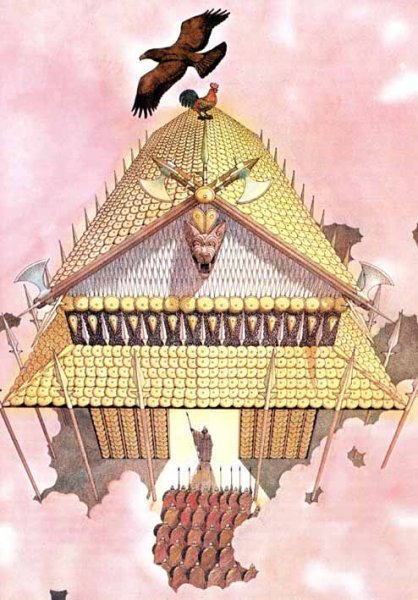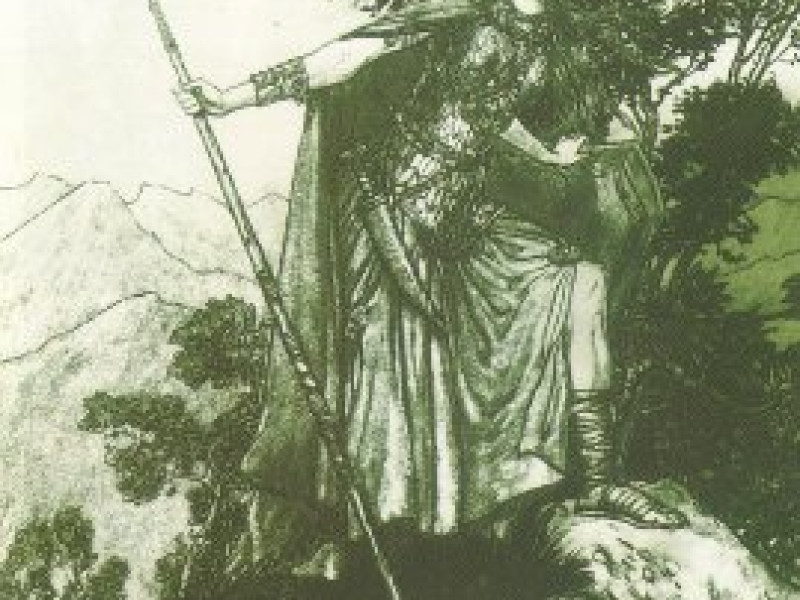Valhalla
Of Valhalla, the Icelandic Snorri Sturluson gives us the most vivid detail in his Prose Edda.
Valhalla, or "Hall of the Heroes", was the best-known hall in Asgard, which was another residency belonging to Odin, or Val-father ("Father of the Slain") as he was known in this hall. It was where the dead warriors known as Einherjar (Einheriar) resided in a hall, and waited for the arrival of Ragnarök. The Einherjar would fight alongside the Aesir at Ragnarok.
When the bravest warriors were killed in battle or combat, they were brought to Valhalla by a group of women warriors known as the Valkyries, which was translated as "Chooser of the Slain", and they were known as "Battle-maidens" and "Shield-maidens". The Valkyries were sometimes known as "Swan-Maidens" because their garments were made of swan feathers, which allowed them to fly. The Valkyries served Odin by going through a battlefield and choosing slain warriors who would be suited to fight in Ragnarök (Ragnarok). Therefore, they would have a place in Valhalla.
While the Valkyries were in Valhalla, they were known as Mead-Maidens because they were responsible for serving mead to Odin and the Einherjar along the long tables at Valhalla. The mead would come from the goat Heidrun that fed from the foliage on the branches of a tree called Lerad. Each day, the goat's udder would fill the vat with mead.
Andhrimnir, the cook of Valhalla, prepared the meal for the Einherjar. Andhrimnir cooked the wild boar called Sæhrimnir in a great cooking pot, Eldhrimnir. The meat of Sæhrimnir always rejuvenated the warriors at night. Each day Sæhrimnir was cooked before it was served, but by the morning of the next day, the wild boar was whole, ready to be cooked again.
Odin usually dined with his warriors, but he never ate any meat placed before him. Odin would give his meat to the two wolves, Geri and Freki, that rested at his feet. Odin only drank wine with the dead warriors.
Snorri explained that while the Einherjar waited for Ragnarok, they fought each other in a sort of mock battle during the day, but at night they enjoyed a great feast before resting in their beds. In the morning, the Einherjar woke to the crowing of a cock called Salgofnir which was perched on the rooftop of Valhalla.
Snorri wrote that Valhalla had overlapping shields for a roof, held up by the spear-shafts as rafters. There were 540 doors. And from each of the doors, eight hundred warriors could enter or leave the hall. Instead of torch-fires, the light in the great hall came from the glowing blades of swords. Mail shirts were strewn on the benches. In front of the western doors, there hung a wolf. Hovering above Valhalla was a single eagle. There was also a tree standing in front of the doors of Valhalla; the tree was called Glasir because of its red-gold foliage.
Another hall that the fallen warriors resided in was called Vingolf, which means either "wine-hall" or "friend-hall", but this may be the hall for righteous men to live, and not just for the Einherjar. Another name for Vingolf is Gimle, and it was a Norse version of the Elysian Fields or the Blessed Isle. Snorri said Vingolf or Gimle was the fairest of places, located on the southernmost end of heaven.
Snorri also mentioned other heavens. Also to the south but above Vingolf was Andlang. The third heaven, called Vidblain, was above the two previous heavens.
Only half of the slain warriors (Einherjar) in battle were given to Odin. Freyja had the honour of receiving the other half, and the other Einherjar resided with her in Folkvang ("Field of Folk"), her hall within her palace Fólkvangar (Folkvangar). The other hall she resided in was called Sessrumnir. The handmaiden named Fulla attended Freyja (most writers said that Fulla was Frigg's attendant).
By Jimmy Joe






